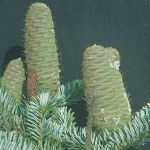| Common Name: |
European Silver Fir |
| Other Names: |
Silver Fir |
| Botanical Name: |
Abies alba syn A. pectinata |
| Genus: |
Abies |
| Family: |
Pinaceae |
| Native Location: |
Mountains of C and SE Europe |
| Cultivation: |
Deep, moist, well-drained, slightly acidic soil in sun or shade. Young trees and A. balsamea Hudsonia Group are more tolerant of alkaline conditions. Firs are sensitive to atmospheric polution. They may also be damaged by late spring frosts as the new shoots appear earlier in mild areas than they would in the wild. Planting in light shade, rather than full sun, minimizes damage. Maintain a single leading shoot by cutting out competing shoots flush with the main stem in spring. Firs may be attacked by sap-sucking adelgids, and are prone to dieback and rust caused by fundal infections. |
| Propagation: |
By seed sown in spring. |
| Harvest: |
Leaves and young shoots are collected in spring. Bark is removed throughout the year. Resin is tapped from 60-80 year old trees, in spring, for distillation of oil. Oleo-resin is collected at any time from blisters on the trunk. |
| Height: |
45m (150ft) |
| Width: |
20m (70ft) |
| Hardiness: |
Z5-8 |
| Parts Used: |
Leaves, resin |
| Properties: |
An aromatic, antiseptic herb that acts as a diuretic and expectorant, and irritates the tissues, causing greater blood flow to the area. |
| Medicinal Uses: |
Internally and externally as a common ingredient in remedies for coughs and colds. Externally also in bath extracts, rubbing oils and liniments, for rheumatism and neuralgia. |
| Culinary Uses: |
Source of honeydew honey, regarded as a tonic in parts of Europe. Inner bark is made into bread by Lapps and Eskimos. |
| Economic Uses: |
Oil of turpentine is an important solvent in the paint industry. The residue, known as "rosin oil", is used in the manufacture of varnishes, lacquers, and carbon black (for pigments and ink). |
| Bibliography: |
Encylopedia of Herbs by Deni Brown Copyright ©: 1995, 2001 Dorling Kindersley Limited pps. 96-97
|

